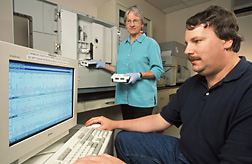Arcobacter: Genome of Foodborne Pathogen Exposed
A little-known microbe called Arcobacter butzleri may make you sick if the water you drink or food you eat is contaminated with it.
But Agricultural Research Service microbiologist William Miller and colleagues have deciphered the sequence of the bacterium’s genetic material. This scientific coup—a first for any of the world’s Arcobacters—may speed discovery of innovative ways to control the microbial miscreant.
Many medical professionals regard A. butzleri as an emerging cause of foodborne disease, according to Miller. Based at the ARS Western Regional Research Center in Albany, California, near San Francisco, he did the genome-sequencing work with colleagues there and with others in the United States and abroad.
The target microbe has been implicated as a cause of outbreaks of food-related illnesses in Europe and Southeast Asia. It is associated with an array of unpleasant symptoms, including diarrhea, stomach cramps, nausea, vomiting, and fever—all of which can become chronic if left untreated.
Previously, the microbe was thought to be a species of Campylobacter, the world’s leading cause of bacterial diarrhea. Later, A. butzleri was reclassified to the Arcobacter genus.
Now, by comparing A. butzleri’s genetic makeup to that of other microbes, Miller and coinvestigators can learn more about its relatedness to them. Such comparisons are important: They may yield clues to A. butzleri’s survival strategies and—perhaps more importantly—to previously unknown vulnerabilities that scientists could exploit to keep food and water safe.
But A. butzleri hasn’t made such comparisons easy.
The team’s analysis has already revealed that many A. butzleri genes “don’t seem to match up” with those from other microbes, Miller says. His observation is based on comparing A. butzleri’s genome sequence to other sequences posted on the World Wide Web.
“We don’t know what these unique A. butzleri genes do,” says Miller. “That’s one of the things that makes this pathogen so interesting.”
While research to discover the function of all of A. butzleri’s genes continues, Miller has already used the genomic data in developing what’s known as a “typing method.” Medical professionals, public health agencies, and researchers can use it when they’re tracking the source of foodborne-illness outbreaks.
Based on technology known as “multi-locus sequence typing,” the assay distinguishes A. butzleri from several cousins that could be outbreak culprits, namely A. cibarius, A. cryaerophilius, and A. skirrowii. And the typing method does more than just differentiate these species. It also “accurately and unambiguously fingerprints strains within each species,” Miller points out. “That makes it especially useful for investigating the source of outbreaks.”
Other scientists are already using the new assay, Miller says. He expects his scientific journal article on the test to be published this year. His article on sequencing the complete A. butzleri genome appeared in 2007 in the online journal PloS ONE.—By Marcia Wood, Agricultural Research Service Information Staff.
This research is part of Food Safety, an ARS national program (#108) described on the World Wide Web at www.nps.ars.usda.gov.
William G. Miller is in the Produce Safety and Microbiology Research Unit, USDA-ARS Western Regional Research Center, 800 Buchanan St., Albany, CA 94710; phone (510) 559-5992, fax (510) 559-6162.
"Arcobacter: Genome of Foodborne Pathogen Exposed" was published in the April 2009 issue of Agricultural Research magazine.







